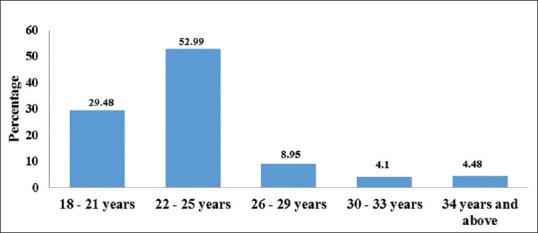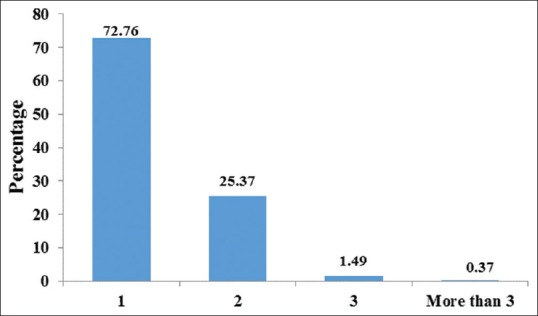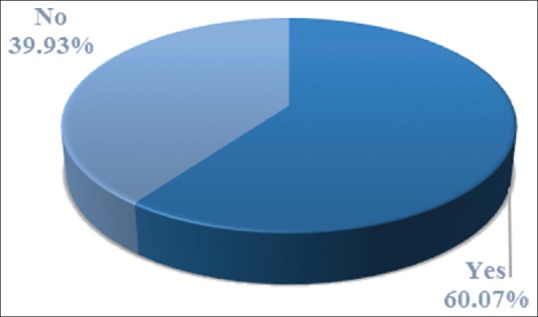Abstract
Background:
With the introduction of multiple uses of mobile phones, including social networking sites, people are being addicted to the device. Most people carry the device to places which are loaded with possible pathogenic microorganisms such as toilets and washrooms, enabling the device to act as a potent fomite.
Aims and Objective:
This study aims to determine the presence of potential pathogenic and multidrug-resistant (MDR) bacteria on the surface of mobile phones used by different occupational groups. It also aims to identify a possible relationship between mobile phone usage in toilets and mobile phone usage while eating.
Materials and Methods:
Two hundred and sixty-eight interviewees belonging to four different occupational groups; 204 students, 24 security staffs, 21 food vendors, and 19 cleaning staff participated in the study in a university, of which 67.54% (n = 181/268) admitted to carry their mobile phones into toilets and 60.07% (n = 161/268) of the total respondents stated that they used their mobile phones while being confined in toilets.
Results:
MDR bacterial presence were observed for both case (90.54%, n = 67/74) and control (73.07%, n = 19/26) study of the 100 swabbed samples and the association between usage of the mobile phone while being confined in toilets and while eating by the same respondent were statistically significant (P = 0.00 ≤ 0.05).
Conclusion:
The study signifies that mobile phones are carriers of pathogenic and MDR bacteria. Therefore, cleanliness and hygiene issues should be prioritized with an awareness to minimize or restrict the use of mobile phones in unfavorable and unhygienic environments such as toilets and washrooms.
Keywords: Bacterial contamination, case and control, mobile phone, multidrug resistant, occupational group, toilets
INTRODUCTION
Mobile phones are now a necessary accessory to maintain personal, social, and professional life. Increasing technological applications have led to increased use of this device to provide not only better communication[1] but also as a portal to access information, listen to music, play video games, etc. In many countries, mobile phones outnumber the landline telephones since most adults and many children now own mobile phone.[2] According to Statista (2018), around 4.57 billion people all over the world are using mobile phones, and in the year 2016, an estimated 62.9% of the world's population already owned a mobile phone.[3] At present, Asia has the fastest growth rate of mobile phone subscribers around the world.[2] Despite many positive aspects, the intense use and engagement with mobile phones have proved to be an addiction and excessive dependency on the technology leads to serious psychological and behavioral impacts on the user.[4] This addiction is leading personals to use mobile phones even in environments which are not hygienic such as the toilets and washrooms.[5] Studies have shown that mobile phones are constantly being used and handled by the owners in places such as toilets, hospitals, and kitchens which are typically loaded with microorganisms.[6]
The constant handling of the phone by different users exposes to an array of microorganisms and makes a good carrier of for microbes, especially those associated with the skin resulting in the spread of different microorganisms from user to user. Therefore, mobile phone is not only transmitting voice and messages but also microorganisms and some of which are reported to be pathogenic. Maximum human pathogenic bacteria are mesophilic, referring to maximum colony growth at temperature ranging from 20°C to 45°C (37°C most favorable). On this note, studies include that the average temperature of the smartphone that we use varies between 25°C and 32°C in normal condition.[7] During charge intake, the phone temperature might reach to 37°C–43°C, making the phone a favorable breeding zone for the bacteria. Perhaps, as females are more comfortable carrying the mobile phones in their handbags, a study reports that the heat generated by the mobile phones and the internal areas of the bag provides support to breeding of bacteria.[8]
Several studies have also determined the presence of bacteria on the surface of the mobile phone, especially in medical facilities, where it is a matter of great concern. A study reported that many species of commonly found bacteria such as Staphylococcus aureus, Staphylococcus epidermidis, Pseudomonas aeruginosa, Neisseria sicca, Micrococcus luteus, Proteus mirabilis, Bacillus subtilis, and Enterobacter aerogenes were identified on mobile phone surface.[6] Other studies included that coagulase-negative staphylococcus, S. aureus, Escherichia coli, Enterococcus faecalis, Klebsiella pneumonia, Bacillus spp., and P. aeruginosa[9,10,11] were also present on the surface of the mobile phone.
Our study focuses on the determination of potential pathogenic and multidrug-resistant (MDR) bacteria on the surface of mobile phones used by different occupational groups to identify a relationship between mobile phone usage in toilets and mobile phone usage during food intake by the study respondents.
MATERIALS AND METHODS
A questionnaire survey was conducted among four different occupational groups at Independent University, Bangladesh located in Dhaka, Bangladesh, which included 268 interviewees (204 students, 24 security staffs, 21 food vendors, and 19 cleaning staffs). The university was specifically chosen to target the respondents with age under 25 who are the more habitual users of mobile phones in their daily lives. Samples were swabbed in two phases from the back and front surface of the mobile phones of the respondent with a sterilized cotton bud which was preserved in Ringer's solution. At the first stage, 74 mobile samples were swabbed for a case study from the 268 interviewees randomly, including participants from each category right after their visit from the toilets. The similar procedure was adopted to collect 26 other mobile phone samples for a control study in the second stage, but this time the mobile phones were sterilized with 70% ethanol before the respondents visited and used the mobile phone in the toilets. After the sample collection for both case and control measure, the swabs were placed in Petri dishes containing selective MacConkey agar (Oxoid: CM0007) media for 24–48 h at 37°C for probable bacterial growth. Samples were isolated from the growth media to fresh media with the help of sterilized inoculation loop, and later, the dishes were preserved for an antibiotic sensitivity test adopting the disc diffusion method (Kirby–Bauer antibiotic test) under similar laboratory condition and 12 different antibiotics (amoxicillin, ampicillin, azithromycin, chloramphenicol, ciprofloxacin, erythromycin, kanamycin, norfloxacin, penicillin, streptomycin, sulfisoxazole, and tetracycline) were introduced to observe the bacterial growth and resistance level. Records of the data were maintained, organized, and stored with the help of Microsoft Excel and STATA 12 (Statacorp LLC, 4905 Lakeway Drive, College Station, Texas, USA) was used for a comparative analysis.
RESULTS
Survey results and analysis
Out of 268 interviewees, 49.25% (n = 132) respondents were male and 50.75% (n = 136) were female. There were higher number (n = 142, 52.99%) of respondents belonging to age group from 22 to 25 years and a minimum amount (n = 11, 4.10% and n = 12, 4.48%) of respondents belonged to the age groups of 30–33 years and 34 years and above, respectively [Figure 1]. In total 204 (76.12%) students, 21 (7.84%) food vendors, 24 (8.96%) security staffs, and 19 (7.09%) cleaning staffs were interviewed for the survey [Table 1].
Figure 1.

Age distribution among respondent
Table 1.
Occupation of the respondents of the survey
| Occupation | Male | Female | Total |
|---|---|---|---|
| Student | 98 | 106 | 204 (76.12%) |
| 48.04% | 51.96% | 100% | |
| Food vendor | 13 | 8 | 21 (7.84%) |
| 61.90% | 38.10% | 100% | |
| Security staff | 17 | 7 | 24 (8.96%) |
| 70.83% | 29.17% | 100% | |
| Cleaning staff | 4 | 15 | 19 (7.09%) |
| 21.05% | 78.95% | 100% | |
| Total (n) | 132 | 136 | 268 |
| Percentage | 49.25% | 50.75% | 100% |
All the respondents in the survey owned a minimum of at least one mobile phone. 72.76% (n = 195) of the total 268 respondents were reported to use a minimum of one mobile phone [Figure 2]. Maximum respondent (n = 208, 77.61%) preferred to use screen touch mobile phones, while 9.33% (n = 25) respondents preferred a Symbian (or nontouch screen) phone and 13.06% (n = 35) of the respondents used both Symbian and screen touch phones.
Figure 2.

Number of mobile phones owned by an individual of the survey
About 58.59% (n = 157) of the respondents in the study visited the toilets more than two times in a day, provided if their health condition was in good state. Females were reported to visit the toilet more than twice in a day comparing to the males. 30.22% (n = 81) of the 268 respondents visited the washroom more than three times in a day and the association between gender and time of toilet visit was statistically significant (P = 0.031 ≤ 0.05). Again, of the total study population, 45.15% (n = 121) spend more than 3 min but <5 min in the toilets and only 2.24% (n = 6) respondent spend more than 15 min in the toilets. The statistical association for gender and time spent in the toilets was also reported to be significant (P = 0.006 ≤ 0.05) [Table 2].
Table 2.
Gender and toilet visit records of the survey
| Gender | Total | P (≤0.05) | ||
|---|---|---|---|---|
| Male | Female | |||
| Number of time visiting the washroom (per day) | ||||
| Once | 20 | 10 | 30 (11.19%) | 0.031 |
| 66.67% | 33.33% | 100% | ||
| Twice | 46 | 35 | 81 (30.22%) | |
| 56.79% | 43.21% | 100% | ||
| Thrice | 31 | 45 | 76 (28.36%) | |
| 40.79% | 59.21% | 100% | ||
| More than three times | 35 | 46 | 81 (30.22%) | |
| 43.21% | 56.79% | 100% | ||
| Total (n) | 132 | 136 | 268 | |
| Percentage | 49.25% | 50.75% | 100% | |
| Time spend in washroom (per day) | ||||
| <3 min | 13 | 28 | 41 (15.30%) | 0.006 |
| 31.71% | 68.29% | 100% | ||
| 3 min < duration <5 min | 60 | 61 | 121 (45.15%) | |
| 49.59% | 50.41% | 100% | ||
| 5 min < duration <8 min | 40 | 36 | 76 (28.36%) | |
| 52.63% | 47.37% | 100% | ||
| 8 min < duration <15 min | 18 | 6 | 24 (8.96%) | |
| 75.00% | 25.00% | 100% | ||
| Duration >15 min | 1 | 5 | 6 (2.24%) | |
| 16.67% | 83.33% | 100% | ||
| Total (n) | 132 | 136 | 268 | |
| Percentage | 49.25% | 50.75% | 100% | |
About 67.54% (n = 181) of the total 268 respondents admitted to carry mobile phone in the toilets [Figure 3] and 60.07% (n = 161) respondent out of 268 agreed to use their mobile phone while being confined in the toilets [Figure 4]. Further analysis estimated that out of all occupational categories, the food vendors were more likely to use mobile phone while being confined in the toilets [Table 3].
Figure 3.

Caring mobile phone in toilets
Figure 4.

Using mobile phone in toilets
Table 3.
Use of cell in toilets by different occupational groups
| Occupational | n | Used mobile in toilets (always - rarely) | Percentage |
|---|---|---|---|
| Student | 204 | 136 | 66.67 |
| Food vendor | 21 | 15 | 71.42 |
| Security staff | 24 | 8 | 33.33 |
| Cleaning staff | 19 | 2 | 10.52 |
| Total (n) | 268 | 161 | 60.07 |
A bivariate analysis stated that there was a strong statistical association (P = 0.000 ≤ 0.05) between respondents using mobile phone in the toilets and using the phone while eating [Table 4].
Table 4.
Using mobile phone in washroom and during food intake
| Variables Mobile phone use during food intake |
Use of mobile in washroom | Total | P (≤0.05) | ||||
|---|---|---|---|---|---|---|---|
| Always | Frequently | Sometimes | Rarely | Never | |||
| Always | 4 | 0 | 4 | 1 | 0 | 9 (3.36%) | 0.000 |
| 44.44% | 0% | 44.44% | 11.11% | 0% | 100% | ||
| Most often | 4 | 12 | 11 | 7 | 8 | 42 (15.67%) | |
| 9.52% | 28.57% | 26.19% | 16.67% | 19.05% | 100% | ||
| Sometimes | 5 | 12 | 17 | 24 | 32 | 90 (33.58%) | |
| 5.56% | 13.33% | 18.89% | 26.67% | 35.56% | 100% | ||
| Rarely | 2 | 7 | 15 | 16 | 26 | 66 (24.63%) | |
| 3.03% | 10.61% | 22.73% | 24.24% | 39.39% | 100% | ||
| Never | 2 | 3 | 7 | 8 | 41 | 61 (22.76%) | |
| 3.28% | 4.92% | 11.48% | 13.11% | 67.21% | 100% | ||
| Total (n) | 17 | 34 | 54 | 56 | 107 | 268 | |
| Percentage | 6.34% | 12.69% | 20.15% | 20.90% | 39.93% | 100% | |
Laboratory test results and analysis
Bacteria (Family: Enterobacteriaceae) presence was observed in 90.54% (n = 67) mobile phone samples out of 74 respondents for the case study and in the control study 73.07% (n = 19) of the samples were found to be contaminated by similar bacterial colony out of the rest 26 samples [Table 5].
Table 5.
Bacteria presence on mobile phone surface of different professions
| Occupational group | Case study | Control study | ||||
|---|---|---|---|---|---|---|
| Presence | Absence | Total | Presence | Absence | Total | |
| Student | 44 | 6 | 50 | 8 | 4 | 12 |
| 88% | 12% | 100% | 66.66% | 33.33% | 100% | |
| Food vendor | 11 | 0 | 11 | 6 | 0 | 6 |
| 100% | 0% | 100% | 100% | 0% | 100% | |
| Security staff | 5 | 0 | 5 | 3 | 1 | 4 |
| 100% | 0% | 100% | 75% | 25% | 100% | |
| Cleaning staff | 7 | 1 | 8 | 2 | 2 | 4 |
| 87.50% | 12.50% | 100% | 50% | 50% | 100% | |
| Total (n) | 67 | 7 | 74 | 19 | 7 | 26 |
| 90.54% | 9.46% | 100% | 73.07% | 26.92% | 100% | |
Out of all the study samples, five samples were randomly chosen depending on the bacterial colony growth and later subcultures of the individual colony were exposed to 12 different antibiotics.
All the subsamples were proved to be MDR (MDR: Multidrug resistant) [Table 6].
Table 6.
Antibiotic sensitivity test of the selected bacterial isolates
| Antibiotics | Potency | Isolation number (mm) | ||||||
|---|---|---|---|---|---|---|---|---|
| Resistant | Intermediate | Susceptible | 9 | 10 | 53 | 88 | 94 | |
| Amoxicillin | ≤13 | 14-17 | ≥18 | 11 | 0 | 0 | 9 | 8 |
| Ampicillin | ≤13 | 14-16 | ≥17 | 7 | 0 | 0 | 11 | 11 |
| Kanamycin | ≤13 | 14-17 | ≥18 | 17 | 17 | 15 | 15 | 14 |
| Ciprofloxacin | ≤15 | 16-20 | ≥21 | 19 | 31 | 21 | 19 | 23 |
| Azithromycin | N/A | N/A | N/A | 18 | 29 | 18 | 21 | 17 |
| Erythromycin | ≤13 | 14-22 | ≥23 | 15 | 0 | 0 | 13 | 4 |
| Norfloxacin | ≤12 | 13-16 | ≥17 | 13 | 30 | 25 | 13 | 27 |
| Sulfisoxazole | ≤12 | 13-16 | ≥17 | 12 | 0 | 0 | 10 | 14 |
| Penicillin | N/A | N/A | N/A | 0 | 0 | 0 | 0 | 0 |
| Streptomycin | ≤11 | 12-14 | ≥15 | 13 | 15 | 14 | 13 | 17 |
| Tetracycline | ≤11 | 12-14 | ≥15 | 11 | 12 | 11 | 9 | 14 |
| Chloramphenicol | ≤12 | 13-17 | ≥18 | 0 | 10 | 16 | 0 | 12 |
N/A: Not available
DISCUSSION
With the increasing rate of mobile phone services, people are more dependent on the device now as it brings solutions within fingertips; for example, a few decades ago people used to spend more time in the library to gather information on a topic but now with the help of internet and search engines in the mobile phones, it has become quick and easy. Therefore, individuals are being more engaged with the device as it serves both necessary and entertaining purposes. According to a survey conducted by the marketing company, “11 marks” published on CBS news (2012); 75% of the Americans admitted to use the cell phone while being confined in the toilets.[12] The UK-based online newspaper “Mail Online” published a report on February 15, 2017 stating that 41% of the Australians are using the mobile in the toilets.[13] The US-based weekly magazine “Time” recently (April 12, 2018) published a report on the fact of using mobile phone in the washroom. In the report, the author Haslam includes that, large fractions of humanity admit to reading in the bathroom, especially when reading on digital devices is included.[14]
From our study, it was observed that 67.54% (n = 181) of the total 268 respondents admitted to carry mobile phone in the toilets and 60.07% (n = 161) respondent out of 268 agreed to use their mobile phone while being confined in the toilets. 90.54% (n = 67/74) of the collected samples were contaminated with MDR bacteria which were more resistant to the antibiotics: Amoxicillin, ampicillin, erythromycin, sulfisoxazole, tetracycline, and chloramphenicol. Almost similar percentage of presence was observed in a study where 91.7% (n = 176) of the total mobile phone samples were contaminated with pathogenic bacteria.[6] A study conducted in King Abdul-Aziz University at Jeddah, Saudi Arabia, reported that 96.2% (n = 101) of the mobile phones of the students were contaminated with bacteria[5] where another study conducted in New York and Israel reported that 94.5% of 200 health workers and their mobile phones were contaminated by various microorganisms which included nosocomial pathogens.[15] On the contrary, from this study, it was also observed that the bacterial presence on the mobile phone surfaces decreased to 73.07% (n = 19/26) when they were sterilized with 70% ethanol before usage. Similarly, a study conducted in Iran testified that 70% ethyl alcohol or 70% isopropyl alcohol acts successfully and efficiently to decontaminate the surface of the mobile phones.[10] Moreover, from this study, it was recorded that there was a strong statistical association (P = 0.000 ≤ 0.05) between respondents using mobile phone in the toilets and using the phone while eating which surely concerns the hygiene issue and bacterial transmission opportunity.
CONCLUSION
There is no doubt about the importance of mobile phones in our regular life, but at the same time, it also includes some negative consequences. It has been observed that by being addictive to the device, people are often carrying and using the device in inappropriate places and environments which might affect their health, such as: washroom and toilets. Our study claims that 90.54% of the mobile phone samples were contaminated with pathogenic and MDR bacteria and the owners reported to use the device in toilets and washrooms and also during food intake. It is quite natural that people are using their mobile phones while being confined in the toilets, in order to pass their time, but it is very unfortunate that many of the users are not aware about how contaminated the mobile phone surface can become and how it can act as a carrier of microbes. Therefore, cleanliness and hygiene issues should be prioritized with an awareness to minimize or restrict the use of mobile phones in unfavorable and unhygienic environments.
Financial support and sponsorship
The study was financially supported by Environmental Science Laboratory, Independent University Bangladesh.
Conflicts of interest
There are no conflicts of interest.
REFERENCES
- 1.Tambe NN, Pai C. A study of microbial flora and MRSA harbored by mobile phones of health care personnel. Int J Rec Trends Sci Technol. 2012;4:14–8. [Google Scholar]
- 2.Anuradha SN, Arunkumar S, Mekhanayakee M, Shyen WY, Arwintharao A. Study on awareness of microbial contamination through mobile phones. Asian Pac J Health Sci. 2016;3:313–23. [Google Scholar]
- 3.Number of Mobile Phone users Worldwide from 2015 to 2020 (in billions) 2018. Aug, [Last accessed on 2018 Nov 30]. Available from: https://www.statista. com/statistics/274774/forecast.of.mobile.phone.users.worldwide/
- 4.Leung L, Liang J. Hong Kong China: IGI Global; 2015. Hong Kong, China: IGI Global; 2015; pp. 640–7. [Google Scholar]
- 5.Zakai S, Mashat A, Abumohssin A, Samarkandi A, Almaghrabi B, Barradah H, et al. Bacterial contamination of cell phones of medical students at King Abdulaziz university, Jeddah, Saudi Arabia. J Microsc Ultrastruct. 2016;4:143–6. doi: 10.1016/j.jmau.2015.12.004. [DOI] [PMC free article] [PubMed] [Google Scholar]
- 6.Bhoonderowa A, Gookool S, Biranjia-Hurdoyal SD. The importance of mobile phones in the possible transmission of bacterial infections in the community. J Community Health. 2014;39:965–7. doi: 10.1007/s10900-014-9838-6. [DOI] [PubMed] [Google Scholar]
- 7.What is the Normal Temperature for Android Phones?; (n.d.) [Last accessed on 2018 Aug 28]. Available from: https://www.quora.com/ What-is-the-normal-temperature-for-Android-phones .
- 8.Brady RR, Wasson A, Stirling I, McAllister C, Damani NN. Is your phone bugged?. The incidence of bacteria known to cause nosocomial infection on healthcare workers’ mobile phones. J Hosp Infect. 2006;62:123–5. doi: 10.1016/j.jhin.2005.05.005. [DOI] [PubMed] [Google Scholar]
- 9.Akinyemi KO, Atapu AD, Adetona OO, Coker AO. The potential role of mobile phones in the spread of bacterial infections. J Infect Dev Ctries. 2009;3:628–32. doi: 10.3855/jidc.556. [DOI] [PubMed] [Google Scholar]
- 10.Maryam MS. Bacterial contamination of healthcare workers’ mobile phones and efficacy of surface decolonization techniques. Afr J Microbiol Res. 2011;5:5415–8. [Google Scholar]
- 11.Al-Abdalall AH. Isolation and identification of microbes associated with mobile phones in Dammam in Eastern Saudi Arabia. J Family Community Med. 2010;17:11–4. doi: 10.4103/1319-1683.68783. [DOI] [PMC free article] [PubMed] [Google Scholar]
- 12.Castillo M. Survey: 75 Percent of Americans Admit to using Phone while in Bathroom CBS News. 2012. Feb 2, [Last accessed on 2018 Nov 28]. Available from: https://wwwcbsnewscom/news/survey-75-percent-of-americans-admit-to-using-phone-while-in-bathroom/
- 13.Ingram L. Daily Mail; February, 2017. [Last accessed on 2018 Aug 14]. Available from: https://wwwdailymailcouk/femail/article-4229044/Why-shouldn-t-use-phone-toilethtml .
- 14.Haslam N. In Defense of Using Your Phone on the Toilet. 2018. Apr, [Last accessed on 2018 Jun 02]. Available from: http://timecom/5233044/toilet-phone-reading-germs-smartphone-addiction-bathroom/
- 15.Ulger F, Esen S, Dilek A, Yanik K, Gunaydin M, Leblebicioglu H. Are we aware how contaminated our mobile phones with nosocomial pathogens? Ann Clin Microbiol Antimicrob. 2009;8:7. doi: 10.1186/1476-0711-8-7. [DOI] [PMC free article] [PubMed] [Google Scholar]


